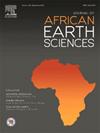尼日利亚东南部阿南布拉盆地重力导数滤波器和剩余大地水准面对地壳形变的意义
IF 2.2
4区 地球科学
Q2 GEOSCIENCES, MULTIDISCIPLINARY
引用次数: 0
摘要
重力数据及其衍生物的分析和解释可以为边缘检测、地质构造和变形模式提供有价值的信息。本研究利用重力导数滤波和剩余大地水准面异常相结合的方法,描绘了尼日利亚东南部Anambra盆地的地壳变形。利用截断水平板块模型从全球重力模型中导出的布格重力异常计算了一阶和二阶垂直和水平导数。利用Airy-Heiskanen均衡模型推导了剩余大地水准面异常。对这些结果进行进一步处理,生成倾角、θ角和倾斜- θ角相关(TTAC)图。衍生图揭示了与裂谷相关的构造活动相关的多个断裂系统和构造走向(N-S, NW-SE, NE-SW),圈定了挤压和伸展域。发现高角度断裂、断层和地堑是控制沉积物分布和潜在储层构造的关键特征。残余大地面和膨胀推力图进一步显示了地壳挤压和伸展带,与沉积负荷和构造隆升区相对应,特别是在盆地的Abakaliki背斜和NE翼。虽然这项研究提供了有价值的结构和地球动力学见解,但它受到卫星导出的重力和大地水准面数据的限制,这些数据可能与陆地地震调查的空间分辨率不匹配。这一局限性表明,尽管解释很可靠,但如果与更高分辨率的地震或井眼数据相结合,将会受益。衍生图显示的断裂和深沉积(沉积中心)表明,盆地具有坚固的构造特征,可能存在油气聚集。本文章由计算机程序翻译,如有差异,请以英文原文为准。
Implications of gravity derivative filters and residual geoid on crustal deformations in the Anambra Basin, Southeast Nigeria
Analysis and interpretation of gravity data and its derivatives can provide valuable information on edge detection, geological structures, and deformation patterns. This study delineates crustal deformation within the Anambra Basin, Southeast Nigeria, using a combined approach of gravity derivative filters and residual geoid anomalies. First- and second-order vertical and horizontal derivatives were computed from Bouguer gravity anomalies derived from a global gravitational model using the Truncated Horizontal Plate Model. Residual geoid anomalies were derived by using Airy-Heiskanen isostatic model. These results were further processed to generate tilt angle, theta, and Tilt-Theta Angles Correlation (TTAC) maps. The derivative maps revealed multiple fault systems and structural trends (N-S, NW-SE, NE-SW) associated with rift-related tectonic activity, delineating compressional and extensional domains. High-angle faults, horsts, and grabens were discovered as the key features controlling sediment distribution and potential reservoir structures. The residual geoid and swell push force maps further made manifest zones of crustal compression and extension, corresponding to areas of sedimentary loading and tectonic uplift, particularly in the Abakaliki Anticlinorium and NE flank of the basin. While this study offers valuable structural and geodynamic insights, it is limited by its reliance on satellite-derived gravity and geoid data, which may not match the spatial resolution of terrestrial seismic surveys. This limitation suggests that the interpretations, though robust, would benefit from integration with higher-resolution seismic or borehole data. The faults and deep sedimentation (depocenters) as revealed in the derived maps demonstrate that the basin has robust structural features indicating a possible existence of hydrocarbon accumulations.
求助全文
通过发布文献求助,成功后即可免费获取论文全文。
去求助
来源期刊

Journal of African Earth Sciences
地学-地球科学综合
CiteScore
4.70
自引率
4.30%
发文量
240
审稿时长
12 months
期刊介绍:
The Journal of African Earth Sciences sees itself as the prime geological journal for all aspects of the Earth Sciences about the African plate. Papers dealing with peripheral areas are welcome if they demonstrate a tight link with Africa.
The Journal publishes high quality, peer-reviewed scientific papers. It is devoted primarily to research papers but short communications relating to new developments of broad interest, reviews and book reviews will also be considered. Papers must have international appeal and should present work of more regional than local significance and dealing with well identified and justified scientific questions. Specialised technical papers, analytical or exploration reports must be avoided. Papers on applied geology should preferably be linked to such core disciplines and must be addressed to a more general geoscientific audience.
 求助内容:
求助内容: 应助结果提醒方式:
应助结果提醒方式:


